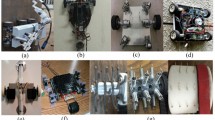Abstract
The MACCEPA (Mechanically Adjustable Compliance and Controllable Equilibrium Position Actuator) is an electric actuator of which the compliance and equilibrium position are fully independently controllable and both are set by two dedicated servomotor. In this paper an improvement of the actuator is proposed where the torque-angle curve and consequently the stiffness-angle curve can be modified by choosing an appropriate shape of a profile disk, which replaces the lever arm of the original design. The actuator has a large joint angle, torque and stiffness range and these properties can be made beneficial for safe human robot interaction and the construction of energy efficient walking, hopping and running robots. The benefit of the ability to store and release energy is shown by the 1DOF hopping robot Chobino1D. The achieved hopping height is much higher compared to a configuration in which the same motor is used without a series elastic element. The stiffness of the actuator increases with deflection, more closely resembling the properties shown by elastic tissue in humans.
Similar content being viewed by others
References
Albu-Schaeffer, A., Eiberger, O., Grebenstein, M., Haddadin, S., Ott, C., Wimboeck, T., Wolf, S., & Hirzinger, G. (2008). Soft robotics: from torque feedback controlled lightweight robots to intrinsically compliant systems. IEEE Robotics & Automation Magazine, 15(3), 20–30.
Alexander, R. M. (1992). Exploring biomechanics: animals in motion. New York: Scientific American Library.
Bicchi, A., & Tonietti, G. (2004). Fast and soft arm tactics: dealing with the safety-performance trade-off in robot arms design and control. IEEE Robotics & Automation Magazine, 11(2), 22–33.
Hosoda, K., Takuma, T., Nakamoto, A., & Hayashi, S. (2007). Biped robot design powered by antagonistic pneumatic actuators for multi-modal locomotion. Robotics and Autonomous Systems, 56(1), 46–53.
Hurst, J. W., & Rizzi, A. A. (2008). Series compliance for robot actuation: application on the electric cable differential leg. IEEE Robotics & Automation Magazine, 15(3), 2008.
Jafari, A., Tsagarakis, N., Vanderborght, B., & Caldwell, D. (2010). A novel actuator with adjustable stiffness (AwAS). In IEEE/RSJ international conference on intelligent robots and systems (IROS 2010) (pp. 4201–4206). New York: IEEE Press.
Kajita, S., Nagasaki, T., Yokoi, K., Kaneko, K., & Tanie, K. (2002). Running pattern generation for a humanoid robot. In IEEE international conference on robotics and automation (ICRA 2002) (Vol. 3, pp. 2755–2761).
Kajita, S., Nagasaki, T., Kaneko, K., Yokoi, K., & Tanie, K. (2005). A Running Controller of Humanoid Biped HRP-2LR. In IEEE international conference on robotics and automation (ICRA) (pp. 616–622).
Playter, R., & Raibert, M. (1992). Control of a biped somersault in 3D. In IEEE/RSJ international conference on intelligent robots and systems (IROS 1992) (pp. 582–589), Raleigh, NC, USA.
Pratt, G. A., & Williamson, M. M. (1995). Series elastic actuators. In IEEE international workshop on intelligent robots and systems (IROS 1995) (pp. 399–406), Pittsburg, USA.
Raibert, M., & Brown, H. J. (1984). Experiments in balance with a 2D one-legged hopping machine. Journal of Dynamic Systems, Measurement, and Control, 106, 75–81.
Raibert, M., Brown, H. J., & Chepponis, M. (1984). Experiments in balance with a 3D one-legged hopping machine. The International Journal of Robotics Research, 3(2), 75–92.
Seyfarth, A., Geyer, H., Blickhan, R., Lipfert, S., Rummel, J., Minekawa, Y., & Iida, F. (2006). Running and walking with compliant legs. In Fast motions in biomechanics and robotics (Vol. 340, pp. 383–401).
Sugar, T. (2002). A novel selective compliant actuator. Mechatronics, 12(9), 1157–1171.
Sulzer, J., Peshkin, M., & Patton, J. (2005). MARIONET: an exotendon-driven, rotary series elastic actuator for exerting joint torque. In International conference on robotics for rehabilitation (ICORR) (pp. 103–108).
Van Ham, R., Vanderborght, B., Van Damme, M., Verrelst, B., & Lefeber, D. (2007). MACCEPA, the mechanically adjustable compliance and controllable equilibrium position actuator: design and implementation in a biped robot. Robotics and Autonomous Systems, 55(10), 761–768.
Van Ham, R., Thomas, S., Vanderborght, B., Hollander, K., & Lefeber, D. (2009). Compliant actuator designs: review of actuators with passive adjustable compliance/controllable stiffness for robotic applications. IEEE Robotics & Automation Magazine, 16(3), 81–94.
Vanderborght, B., Sugar, T., Van Ham, R., Hollander, K., & Lefeber, D. (2008). Comparison of mechanical design and energy consumption of adaptable passive compliant actuators. The International Journal of Robotics Research, 28(1), 90–103.
Vanderborght, B., Van Ham, R., Verrelst, B., Van Damme, M., & Lefeber, D. (2008). Overview of the lucy project: dynamic stabilization of a biped powered by pneumatic artificial muscles. Advanced Robotics, 22(25), 1027–1051.
Vanderborght, B., Verrelst, B., Van Ham, R., Van Damme, M., Beyl, P., & Lefeber, D. (2008). Development of a compliance controller to reduce energy consumption for bipedal robots. Autonomous Robots, 24(4), 419–434.
Versluys, R., Desomer, A., Lenaerts, G., Pareit, O., Vanderborght, B., Perre, G., Peeraer, L., & Lefeber, D. (2008). A biomechatronical transtibial prosthesis powered by pleated pneumatic artificial muscles. International Journal of Modelling, Identification and Control, 4(4), 394–405.
Visser, L., Carloni, R., & Stramigioli, S. (2010). Variable stiffness actuators: a port-based analysis and a comparison of energy efficiency. In 2010 IEEE international conference on robotics and automation (ICRA). IEEE Robotics and Automation Society Press, pp. 3279–3284. Available: http://doc.utwente.nl/72401/
Wolf, S., & Hirzinger, G. (2008). A new variable stiffness design: matching requirements of the next robot generation. In IEEE international conference on robotics and automation (ICRA) (pp. 1741–1746).
Zinn, M., Khatib, O., Roth, B., & Salisbury, J. (2004). Playing it safe [human-friendly robots]. IEEE Robotics & Automation Magazine, 11(2), 12–21.
Author information
Authors and Affiliations
Corresponding author
Rights and permissions
About this article
Cite this article
Vanderborght, B., Tsagarakis, N.G., Van Ham, R. et al. MACCEPA 2.0: compliant actuator used for energy efficient hopping robot Chobino1D. Auton Robot 31, 55–65 (2011). https://doi.org/10.1007/s10514-011-9230-7
Received:
Accepted:
Published:
Issue Date:
DOI: https://doi.org/10.1007/s10514-011-9230-7




